| |
| |
Photographer,
Location |
Images |
Comments |
|

|
Babak Tafreshi,
Fasham, Iran
Dec. 9, 2007 |
#1,
more |
Comet Holmes in a winter freezing mid-night of snow-covered Alborz mountains of Iran.
|
|

|
Günther Strauch,
Borken, NRW, Germany
Dec. 7, 2007 |
#1 |
This evening it was possible to saw Comet Holmes between many clouds. With the naked eye the comet looks as a large, diffuse nebulae. I create a picture of the comet and of the galaxie in the constellation Anromeda (M31) to create a compare in the size and brightness. I create both pictures with a Canon EOS 20D, 800 ASA, 120 secondes exposure with a telephoto lens 135mm/3,5.
Kind regards
Günther
|
|
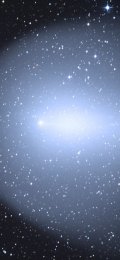
|
Nikolakakos Panagiotis,
Sparta Greece Europe
Dec. 6, 2007 |
#1 |
gso 200/800
canon 350 d
iso 800
288 sec.
|
|
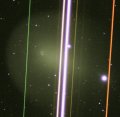
|
Albert Sciesielski,
Waiblingen-Bittenfeld, Germany
Nov. 18, 2007 |
#1, |
Comet Holmes mit Airplane, Canon EOS 350D, 18:10 MEZ, 15 s exposure, 1 600 ISO, 750mm Focal length
|
|

|
Mike Holloway,
Van Buren, Arkansas
Dec. 6, 2007 |
#1 |
It is hard for me to picture just how big this comet has gotten. It took 6 frames with my 5" refractor and ccd camera to cover this area. I still had no sence of size so I have added a picture of the Moon or at least half a Moon at scaled size showing true size. Also shown is the cluster NGC 1245. This image from 2007/12/06
|
|

|
Amir Hossein Abolfath,
Shemshak, Tehran, Iran
Dec. 8, 2007 |
#1 |
Holmes is bright enough still for naked eye observing and it seems like an egg on the sky.
Canon 5D, 50mm Lens, ISO 1600, F/2.4, 14 sec
|
|
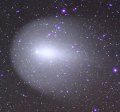
|
Toni Scarmato,
San Costantino di Briatico, Calabria, Italy
Dec. 6, 2007 |
#1,
more |
Comet 17P/Holmes continue his show in Perseus constellation, coma estimed 75' and magnitude steady at 2.7 to naked eye since the last nights.
Fantastic the view in the sky with the comet, Andromeda, Double Perseus Open Cluster, Mars and Pleiades more to East. The sky was very clear and the seeing was optimal.
|
|

|
Philippe Moussette,
Parc des Laurentides Québec Canada
Dec. 8, 2007 |
#1,
#2, more |
The comet Holmes is more biggest of the moon and i took this image at foret momorency Québec Canada Whit 40 D canon camera at 3200 ISO and 100mm 400mm lent at f 5.6.
|
|
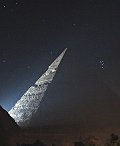
|
Slavko Stojanov,
Giza, near the great pyramids.
Nov. 16, 2007 |
#1 |
A beautiful night-view of pyramids in Giza seen here with comet Holmes and Pleiades on the African sky. Night for a memory.
|
|
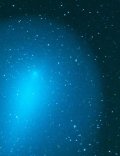
|
Tim Johnson,
La Canada Flintridge, CA
Dec. 5, 2007 |
#1 |
The comet was still visible to the naked eye in light polluted suburban Los Angeles. Nikon D200. ISO 800. AstroPhysics 130mm refractor at f/4.5. Lumicon deep sky light pollution filter. Composite of three two minute exposures.
|
|
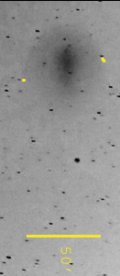
|
Ron Wayman,
Tampa Florida
Dec. 4, 2007 |
#1,
#2 |
Holmes is getting very hard to photograph and even harder to see, if not at all, from city lights. I tried to find it and am not sure if I could see it in my 8x42 binoculars. It was very hard to see in a single image but I was able to bring it out a little after stacking a few images. Just out of curiosity I thought I would try to measure it's width and came up with over 50 arc minutes. It still looks very large in the surrounding star field.
|
|
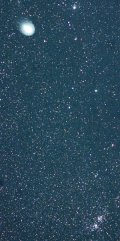
|
Masa Nakamura,
Katsura, Ibaraki, Japan
Dec. 3, 2007 |
#1,
#2 |
Comet Holmes is close to the Double Clusters of the Perseus.
(1)Nikon 85mm(F1.4)+Nikon D70s (ISO1600) 90s-Exp.
(2)Nikon ED400mm(F3.5)+ Nikon D70s (ISO1600) 120s-Exp.
|
more
images (Dec. 8-9):
from
Alexander Gross of Kleinzell, Lower Austria, Austria; from
Runar Sandnes of Reed, Norway; from
Mila Zinkova of San Francisco, California, USA;
more
images (Dec. 6-7): from
Paolo Candy of Ci.A.O. Cimini Astronomical Observatory - Soriano
- Italy; from
Claudio Pincelli of Holyoke, Massachusetts; from
ALBERTO QUIJANO VODNIZA of Pasto, Nariño, Colombia;
more
images (Dec 4-5): from
Ugur Ikizler of Mudanya - Bursa / Turkey; from
Gianni Fardelli of Ascoli Piceno, Italy; from
Paul Klauninger of Almonte, Ontario, Canada; from
Andres Posada of Medellin, Colombia; from
Giuseppe Di Carlo of L'Aquila (Italy); from
P-M Hedén of Vallentuna, Sweden; from
Rolando Ligustri remotely operating a telescope in New Mexico
more
images (Dec. 2-3): from
Chris Schur of Payson, AZ; from
John R. Henley of Starfield Observatory, Nambour, Queensland,
Australia; from
Phillip Jones of McDonald Observatory, Ft. Davis, TX; from
Giancarlo Vignale of Sanremo, Italy; from
Marcel Clemens of Verona, Italy; from
Alex Roca of Hortoneda, Lerida, Spain; from
Ralph Ford of CA Hot Springs, CA; from
John C McConnell of Maghaberry Northern Ireland;
|
|